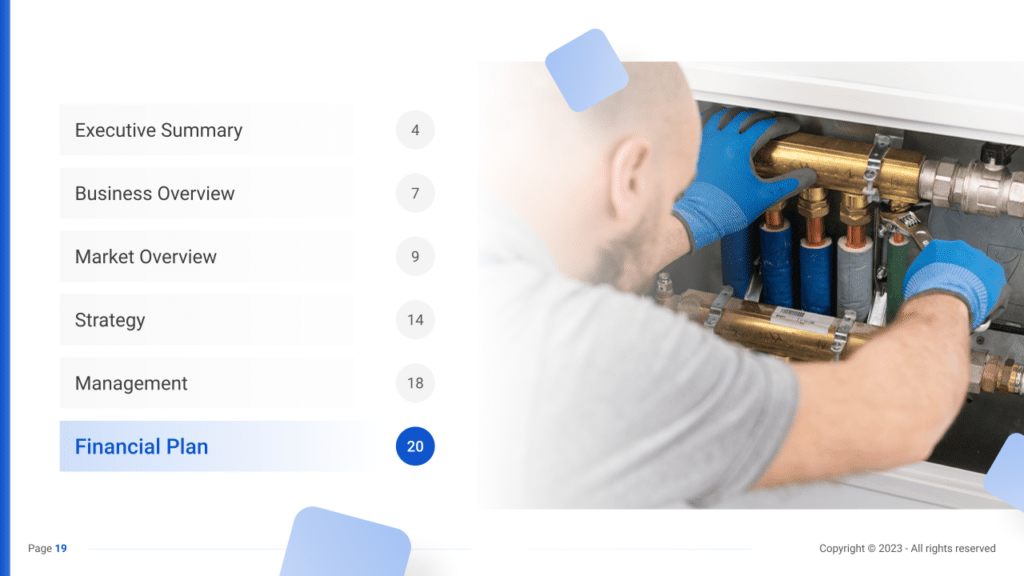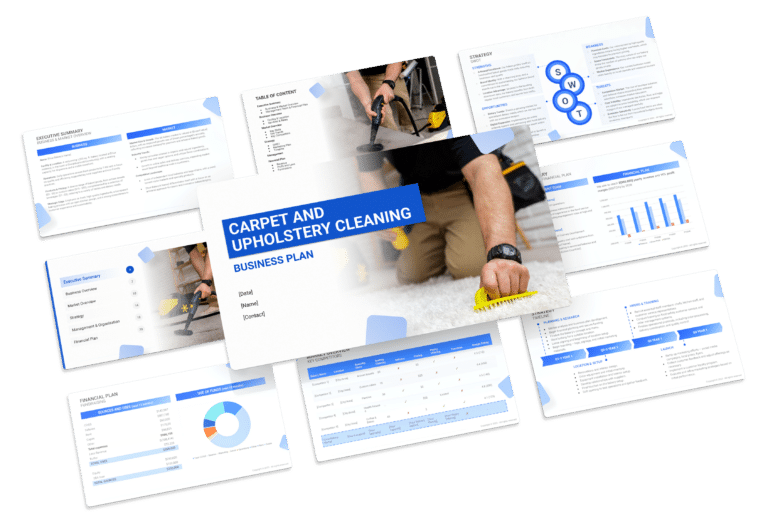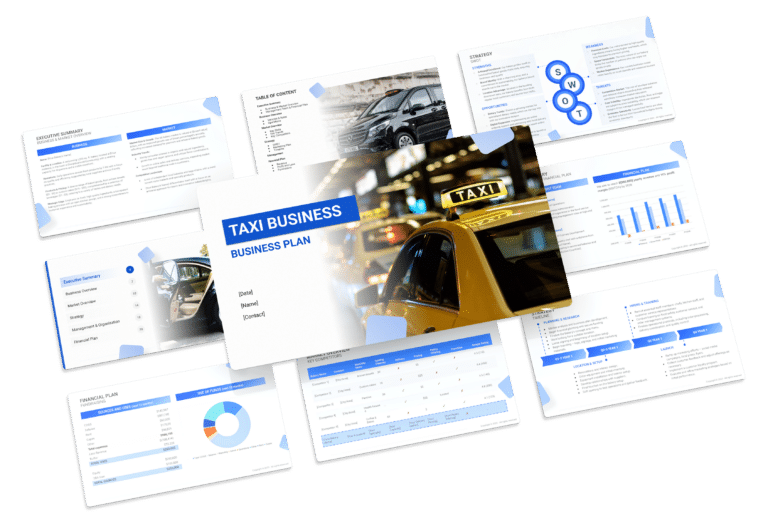Plumbing & HVAC Business Plan Template & PDF Example
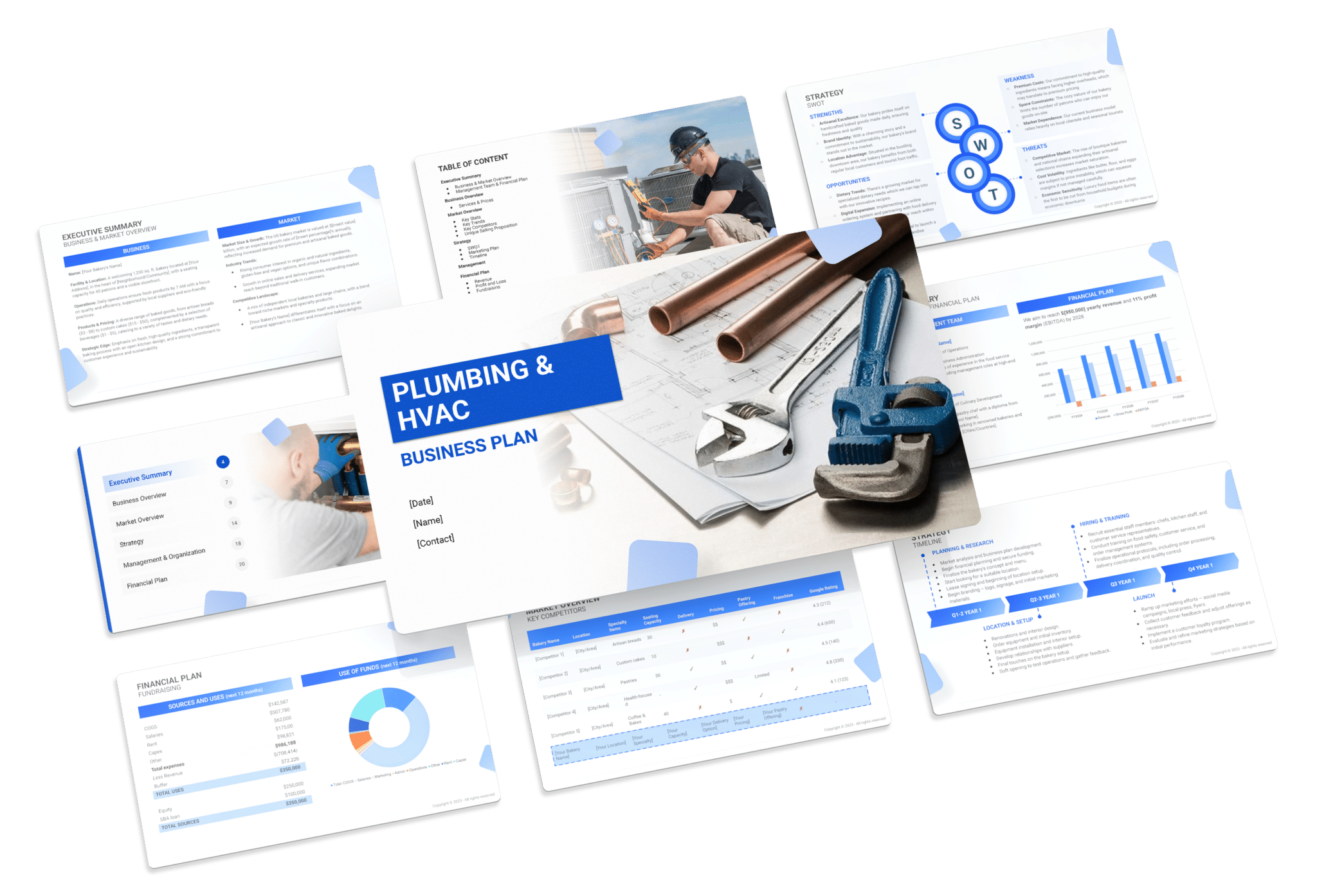
Creating a comprehensive business plan is crucial for launching and running a successful plumbing & HVAC business. This plan serves as your roadmap, detailing your vision, operational strategies, and financial plan. It helps establish your plumbing & HVAC business’s identity, navigate the competitive market, and secure funding for growth.
This article not only breaks down the critical components of a plumbing & HVAC business plan, but also provides an example of a business plan to help you craft your own.
Whether you’re an experienced entrepreneur or new to the service industry, this guide, complete with a business plan example, lays the groundwork for turning your plumbing & HVAC business concept into reality. Let’s dive in!
The Plan
Our plumbing & HVAC business plan is structured to cover all essential aspects needed for a comprehensive strategy. It outlines our company’s operations, marketing strategy, market environment, competitors, management team, and financial forecasts.
- Executive Summary: Offers an overview of your plumbing & HVAC service’s concept, market analysis, management, and financial strategy.
- Business Overview: Provides detailed information on your service and its operational model:
- Services & Prices: Lists the range of plumbing and HVAC services offered, including installation, maintenance, repairs, emergency response, and eco-friendly solutions, with a clear pricing structure.
- Market Overview: Examines the plumbing and HVAC industry landscape, identifying competitors and how your service stands out:
- Key Stats: Shares industry size, growth trends, and relevant statistics for the plumbing and HVAC market.
- Key Trends: Highlights recent trends in the industry, such as the demand for smart, automated solutions, and the rise in energy-efficient systems.
- Key Competitors: Analyzes main competitors in your area and differentiates your service in terms of responsiveness, expertise, and sustainable solutions.
- Strategy: Outlines how the plumbing & HVAC service plans to achieve growth and attract clients:
- SWOT: Strengths, weaknesses, opportunities, and threats analysis tailored to your plumbing & HVAC service.
- Marketing Plan: Specifies marketing strategies to promote your services, including digital advertising, local trade shows, and customer referral programs.
- Timeline: Key milestones and objectives from the initial setup to the first year of operations, detailing steps such as market analysis, legal setup, facility preparation, and launch marketing activities.
- Management: Information on the management team, highlighting their expertise in plumbing and HVAC services, business operations, and development.
- Financial Plan: Projects the 5-year financial performance of the plumbing & HVAC service, including revenue targets, profit and loss statements, fundraising needs, cash flow projections, and balance sheet forecasts.

Executive Summary
The Executive Summary serves as an introduction to your plumbing & HVAC service business plan, offering a succinct overview of your company and its offerings. It should highlight your market positioning, the comprehensive range of plumbing and HVAC services provided, its location, capacity, and a brief on daily operations.
This section should also delve into how your plumbing & HVAC services will assimilate into the local market, including an analysis of the number of direct competitors in the vicinity, identifying who they are, alongside your company’s unique selling points that set it apart from these competitors.
Moreover, it should include details about the management and founding team, outlining their roles and contributions to the company’s success. Additionally, a summary of your financial projections, including anticipated revenue and profits over the next five years, should be included here to give a clear view of your company’s financial strategy.
Plumbing & HVAC Business Plan Executive Summary Example
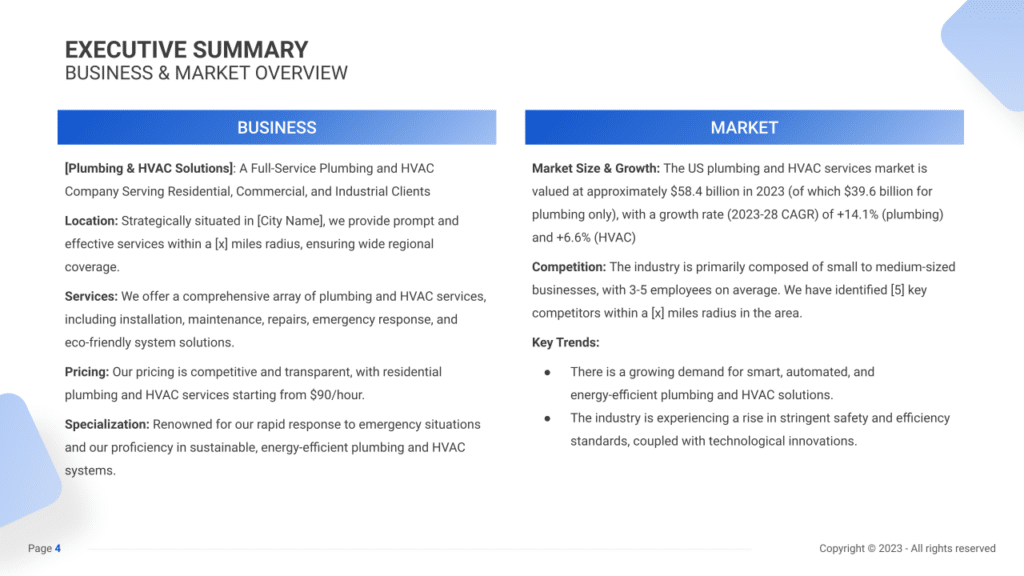

Business Overview
The business overview must succinctly introduce your plumbing & HVAC service, highlighting its name, operational location, and core services.
Example:
“[Plumbing & HVAC Solutions]” is a comprehensive plumbing and HVAC service situated strategically in [City Name]. Our service radius extends [x] miles, ensuring extensive coverage for prompt and efficient solutions in residential, commercial, and industrial settings. We specialize in installation, maintenance, repairs, emergency response, and eco-friendly system solutions, ensuring a diverse range of high-quality services.
Market Overview
Presenting a clear grasp of the market’s size, growth trends, and industry dynamics is crucial. This section should underscore the potential of the plumbing & HVAC industry, supported by relevant market data and growth projections. Highlighting industry trends, such as increasing demand for energy-efficient systems or swift emergency responses, offers insight into your business’s positioning in this evolving landscape.
Example:
Presenting “[Plumbing & HVAC Solutions],” strategically positioned in the US plumbing and HVAC services market stands as a robust and growing sector. Valued at approximately $58.4 billion in 2023, of which $39.6 billion accounts for plumbing services alone, it showcases a compelling growth trajectory. The projected compound annual growth rate (CAGR) from 2023 to 2028 stands at an impressive +14.1% for plumbing and +6.6% for HVAC, indicating substantial opportunities for industry players. Our unique forte lies in rapid emergency response and adeptness in implementing sustainable, energy-efficient solutions. From installations to maintenance and eco-friendly system remedies, we offer a diverse array of top-notch services.
Management Team
The credibility and competence of your management team are integral. Showcase the key qualifications, experiences, and expertise of your team members.
Example:
Plumbing & HVAC Solutions team boasts over 15 years of collective experience in Plumbing & HVAC services. Our founder holds a Bachelor’s degree in Mechanical Engineering, specializing in HVAC and plumbing systems. Complemented by a seasoned partner with a decade of experience in plumbing operations and an MBA in Business Administration, our team ensures a blend of technical prowess and business acumen driving the company’s success.
Financial Plan
A clear summary of your financial goals and projections, including revenue targets and growth strategies, paints a clear financial trajectory for your plumbing & HVAC services.
Example:
With a comprehensive financial strategy, Plumbing & HVAC Solutions aims to achieve an annual revenue milestone of $1.5 million with a targeted profit margin (EBITDA) of [26]%. Through competitive pricing starting at $90/hour for residential services and strategic investments in marketing, technology, and staff training, we forecast a steady revenue increase and market expansion, positioning our business for profitability within the next few years.
Business Overview
Services & Prices
Detail the range of services offered, from routine maintenance and repairs to installations of new systems, including specialized services like energy-efficient upgrades, smart home integrations, or custom solutions for complex systems.
Outline your pricing model, ensuring it reflects the value and quality of services provided and aligns with the market you’re targeting. Highlight any service packages, annual maintenance contracts, or loyalty discounts that offer added value to your clients, encouraging long-term relationships and customer loyalty.

Market Overview

Industry Size & Growth
In the Market Overview of your Plumbing & HVAC service business plan, begin by analyzing the size of the Plumbing & HVAC industry and its growth potential. This analysis is vital for grasping the market’s breadth and pinpointing expansion opportunities.
Key Market Trends
Move on to discuss recent trends in the market, such as the growing consumer demand for energy-efficient systems, smart home integration, and high-quality indoor air services.
For instance, highlight the need for services that offer customized solutions for energy conservation and the increasing popularity of eco-friendly and sustainable HVAC systems.
Competitive Landscape
A competitive analysis is not just a tool for gauging the position of your plumbing & HVAC service in the market and its key competitors; it’s also a fundamental component of your business plan. This analysis helps in identifying your plumbing & HVAC services’ unique selling points, essential for differentiating your business in a competitive market.
In addition, competitive analysis is integral in laying a solid foundation for your business plan. By examining various operational aspects of your competitors, you gain valuable information that ensures your business plan is robust, informed, and tailored to succeed in the current market environment.
Identifying Competitors in the Plumbing & HVAC Industry
Begin your competitive analysis by identifying direct and indirect competitors. Direct competitors might include local plumbing companies and HVAC specialists offering similar services in your service area. Indirect competitors could encompass general contractors offering partial plumbing and HVAC solutions as part of their overall services.
Utilize various resources for competitor mapping. Online directories, local business listings, and service platforms like Angie’s List or HomeAdvisor can help identify competing businesses. Also, customer review platforms such as Yelp or Google Reviews provide insights into customer satisfaction and areas where competitors excel or fall short.

Plumbing & HVAC Services Competitors’ Strategies
Dive into understanding the strategies employed by your competitors:
- Service Offerings: Evaluate the spectrum of services your competitors provide. Do they specialize in emergency repairs, maintenance contracts, eco-friendly solutions, or specific HVAC installations like geothermal systems? Understanding these nuances helps identify areas of specialization or service gaps.
- Technical Expertise and Quality: Assess the level of technical expertise and the quality of work provided by competitors. A company renowned for its high-quality pipe fittings or energy-efficient HVAC installations may attract a particular customer segment seeking superior craftsmanship.
- Pricing Models: Compare your pricing structure with competitors. Some companies might offer competitive pricing with basic services, while others position themselves as premium service providers with added benefits or extended warranties.
- Marketing and Branding: Analyze competitors’ marketing efforts. Do they rely heavily on digital marketing, traditional advertising, or community outreach? A strong online presence, customer testimonials, or certifications might set some competitors apart in the market.
- Customer Service and Satisfaction: Examine the customer experience provided by competitors. Companies offering 24/7 emergency services, responsive customer support, or extended warranties tend to attract and retain clients based on superior service.
- Technology and Innovation: Look into competitors embracing technology for efficiency. This could include the use of advanced plumbing or HVAC systems, smart home integration, or digital tools for scheduling and service management.
What’s Your Plumbing & HVAC Business’s Unique Value Proposition?
Reflect on your business’s distinctive value proposition. It could be expertise in handling complex installations, a focus on sustainable and energy-efficient solutions, or a specialization in historical property renovations requiring specific plumbing and HVAC solutions.
Identify potential market gaps by listening to customer feedback and industry trends. For instance, the growing demand for eco-friendly plumbing fixtures or smart HVAC systems represents an opportunity if competitors have yet to tap into this segment effectively.
Consider your location and target clientele. A plumbing & HVAC service situated in a commercial district might emphasize rapid response times for businesses, while a company situated in a residential neighborhood could prioritize personalized, family-friendly service.
Strategy

SWOT Analysis
First, conduct a SWOT analysis for your Plumbing & HVAC service, identifying Strengths (such as certified technicians and comprehensive service offerings), Weaknesses (including potential scheduling challenges or market saturation), Opportunities (for instance, the growing demand for eco-friendly and smart home solutions), and Threats (like regulatory changes or economic shifts that may impact household spending on home maintenance).
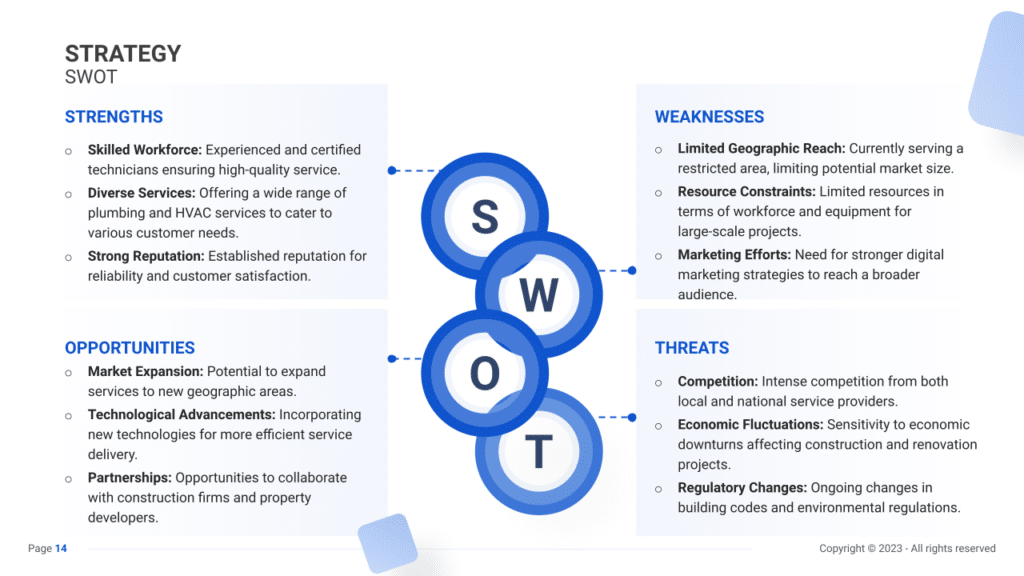
Marketing Plan
Next, formulate a marketing strategy that outlines methods to attract and retain customers through targeted advertising campaigns, promotional service packages, a robust online presence with helpful DIY tips, and participation in local community events or home shows.
Marketing Channels
Utilize a diverse range of marketing channels to reach potential clients and solidify your brand presence:
Digital Marketing
Establishing a strong online presence is critical in today’s digital age:
- Website and SEO: Develop a user-friendly website highlighting your services, expertise, testimonials, and emergency contact details. Implement SEO strategies to enhance visibility in local searches.
- Social Media: Utilize platforms like LinkedIn and Facebook to share industry insights, maintenance tips, client testimonials, and service promotions. Engage with your audience by responding to inquiries promptly.
- Email Marketing: Build an email list and send newsletters with seasonal offers, maintenance checklists, and informative content to engage existing and potential clients.
Local Advertising
Connect with your local community through targeted advertising:
- Local Directories: List your business on local directories and review platforms to enhance visibility in your area.
- Community Engagement: Participate in local trade shows, home improvement expos, or neighborhood events to network and showcase your services.
- Collaborations and Partnerships: Forge partnerships with real estate agencies, property management firms, or construction companies to offer bundled services or referral discounts.
Promotional Activities
Engage prospective clients and incentivize their engagement with your services:
- Seasonal Campaigns: Launch targeted seasonal campaigns such as “Spring HVAC Maintenance Specials” or “Winter Pipe Insulation Discounts” to attract new customers during specific times of the year.
- Referral Programs: Encourage satisfied customers to refer friends, family, or colleagues to your services by offering them incentives. This could include service discounts, complimentary maintenance checks, or priority scheduling.
- Educational Events: Host workshops, webinars, or seminars to educate homeowners or property managers about plumbing and HVAC maintenance. These events establish you as an authority in the field and build trust with potential clients.

Sales Channels
Implement effective sales tactics to maximize revenue and foster client loyalty:
Service Upgrades and Add-ons
Offer additional services and products to enhance value for clients:
- Service Add-Ons: During routine maintenance or installations, suggest additional services such as water quality checks, energy efficiency assessments, or preventive maintenance packages. Educate clients on the benefits these add-ons bring to their homes or businesses.
- Product Sales: Retail high-quality plumbing fixtures, HVAC units, smart thermostats, or water-saving appliances that align with your client’s needs and preferences. Position yourself as a one-stop solution provider for all their plumbing and HVAC requirements.
Online Sales Channels
Facilitate convenient service access and sales through online platforms:
- Online Booking System: Implement an easy-to-use booking system on your website for maintenance visits or emergency services.
- E-Commerce Integration: Sell plumbing fixtures, HVAC parts, or subscription-based maintenance plans through your website for added convenience.
Customer Loyalty Programs
Foster loyalty and repeat business:
- Membership Benefits: Design membership programs offering discounted rates for routine maintenance or priority service scheduling for loyal customers.
- Reward Programs: Establish digital reward programs where clients earn points for each service availed, redeemable for discounts or free services.
Strategy Timeline
Finally, draft a detailed timeline that sets out key milestones for your Plumbing & HVAC service’s launch, marketing initiatives, customer base expansion, and goals for service diversification or geographic growth, ensuring the business progresses with clear objectives and measurable targets.

Management
The Management section focuses on the plumbing & HVAC business’s management and their direct roles in daily operations and strategic direction. This part is crucial for understanding who is responsible for making key decisions and driving the plumbing & HVAC business toward its financial and operational goals.
For your plumbing & HVAC business plan, list the core team members, their specific responsibilities, and how their expertise supports the business.
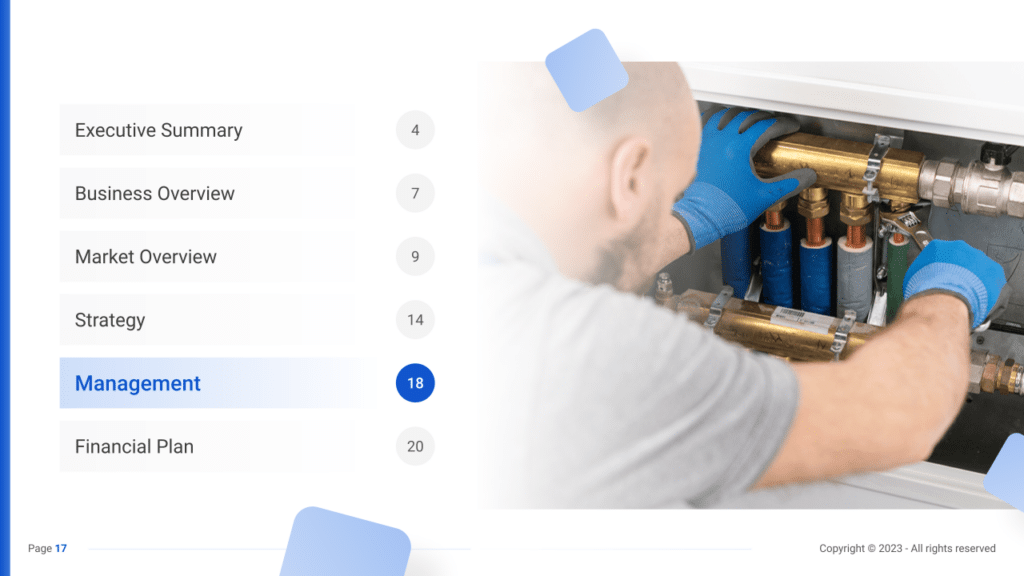

Financial Plan
The Financial Plan section is a comprehensive analysis of your financial projections for revenue, expenses, and profitability. It lays out your plumbing & HVAC business’s approach to securing funding, managing cash flow, and achieving breakeven.
This section typically includes detailed forecasts for the first 5 years of operation, highlighting expected revenue, operating costs and capital expenditures.
For your plumbing & HVAC business plan, provide a snapshot of your financial statement (profit and loss, balance sheet, cash flow statement), as well as your key assumptions (e.g. number of customers and prices, expenses, etc.).
Make sure to cover here
_ Profit and Loss
_ Cash Flow Statement
_ Balance Sheet
_ Use of Funds
